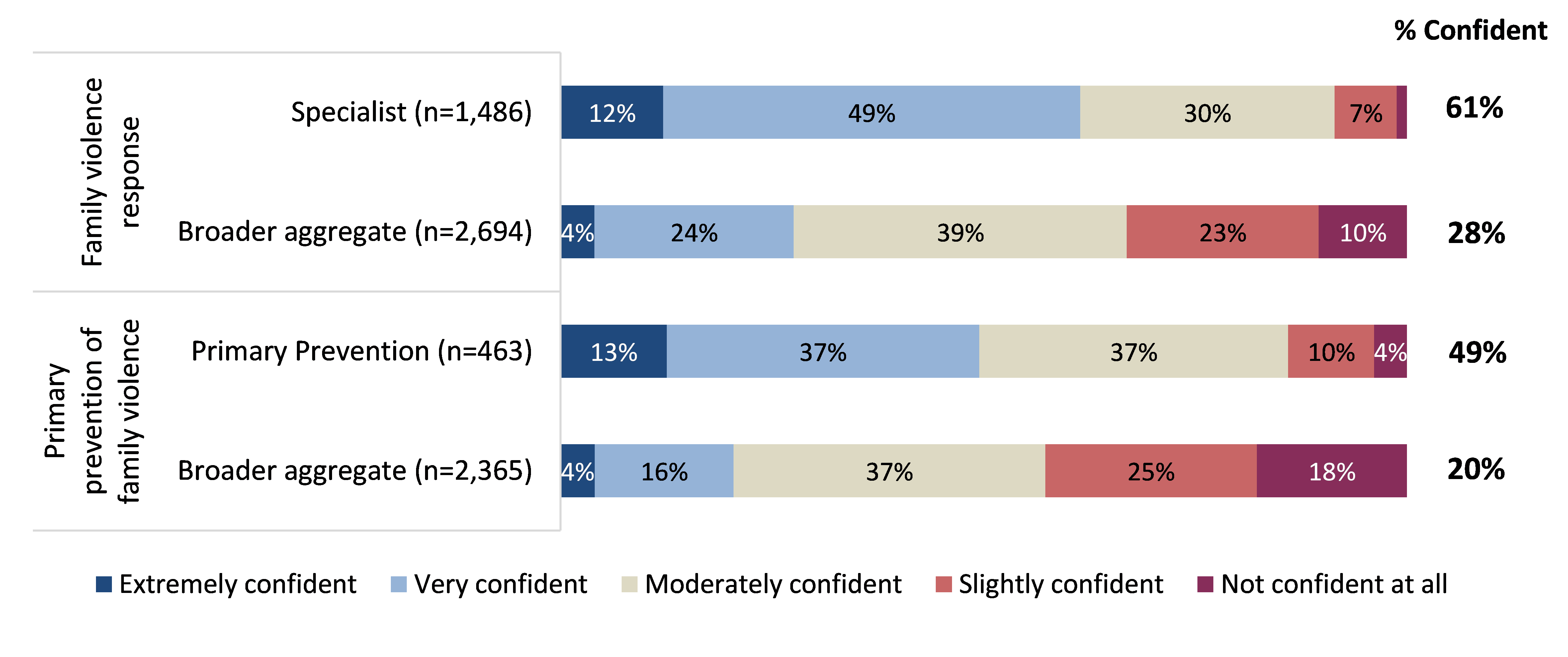Confidence
Around three-in-five specialists indicated that they were ‘extremely’ or ‘very’ confident that they have had enough training and experience to effectively perform their role(s) in relation to family violence response (61%). Those in the broader workforce were also asked about their level of confidence, with only 28% indicating that they were confident.
In relation to the primary prevention of family violence, around half of primary prevention practitioners indicated they were at least very confident (49%), whilst just one-in-five respondents from the broader workforce indicated they were at least very confident (20%).
When asked about what additional support would increase their confidence in performing their role, all workforces indicated that information sharing and collaboration was most important.
MARAM
- 92% of the specialist workforce had heard of the MARAM framework.
- 79% of the primary prevention workforce had heard of the MARAM framework
- 53% of the aggregate broader workforce had heard of the MARAM framework.
The three broader workforce sub-groups with the greatest awareness of the MARAM framework were maternal and child health (95% were aware); alcohol and drug services (86%); and housing and homelessness (80%); whilst ambulance services reported the lowest awareness (7%, see Table 7).
| Workforce | Aware of the MARAM framework (% Yes) | Organisation prescribed to align with the MARAM framework (% Yes) | I have a good understanding of my professional responsibilities under the MARAM framework (% Agree) | In identifying or assessing FV risk, I always use MARAM tools, including a structured professional judgement approach (% Agree) |
|---|---|---|---|---|
| Specialist family violence response (n=946-1,482) |
92% | 81% | 79% | 62% |
| Primary prevention (n=131-474) |
79% | 52% | 56% | 34% |
| Broader workforce aggregate (n=838-2,711 |
53% | 67% | 63% | 39% |
| Alcohol and Drug services (n=119-202) |
86% | 76% | 63% | 35% |
| Ambulance services (n=5-149) |
7% | 55% | Supressed (low sample size) | Supressed (low sample size) |
| Broader community services (n=613-1,401) |
68% | 73% | 61% | 36% |
| Children, Families and Child Protection (n=213-388) |
80% | 78% | 68% | 44% |
| Community Health Services (n=119-306) |
62% | 72% | 53% | 34% |
| Community Mental Health Services (n=71-192) |
61% | 68% | 50% | 24% |
| Court Services (n=19-105) |
50% | 49% | 54% | 37% |
| Disability Services (n=10-119) |
24% | 38% | 73% | 40% |
| Education (n=12-259) |
25% | 23% | 57% | 17% |
| Housing and Homelessness (n=89-167) |
80% | 72% | 54% | 30% |
| Justice (n=33-112) |
61% | 66% | 67% | 45% |
| Legal Services (n=4-58) |
57% | 24% | Supressed (low sample size) | Supressed (low sample size) |
| Maternal and Child Health (n=90-126) |
95% | 90% | 70% | 46% |
| Other Community Services (n=79-269) |
59% | 61% | 60% | 29% |
| Police (n=39-129) |
57% | 60% | 81% | 72% |
| Public health (n=68-523) |
27% | 58% | 53% | 31% |
| Settlement Services (n=8-31) |
48% | 67% | Supressed (low sample size) | Supressed (low sample size) |
| Youth Work (n=57-111) |
78% | 72% | 65% | 32% |
Training
All three workforces were asked to identify the family violence prevention and response topics that they had completed training in, and those they would like further training in. Table 8 illustrates the key findings, by workforce. The top three barriers to accessing further training / development are also shown below.
| Training completed | Helpfulness of completed training (% Helpful) | Training desired in future | Main barriers in accessing further training and development |
|---|---|---|---|
|
Specialist FV response(n=1,415) |
(n=921-1,013) |
(n=1,155) |
(n=1,457) |
|
Family violence risk assessment and risk management (CRAF) (73%) |
75% |
Working with people with disabilities (50%) |
Lack of time (52%) |
|
Identifying and screening family violence (69%) |
82% |
Sexual assault in family violence (48%) |
Cost of study (42%) |
|
Trauma-informed practice (67%) |
88% |
Working with adolescents (48%) |
Location of training facility (32%) |
|
Primary prevention(n=433) |
(n=209-248) |
(n=376) |
(n=461) |
|
Gender equity (59%) |
80% |
Working with Aboriginal communities(52%) |
Lack of time (57%) |
|
Foundation / introductory primary prevention of violence against women (58%) |
75% |
Multi-Agency Risk Assessment and Management (MARAM) (50%) |
Cost of study (42%) |
|
Recognising and responding to disclosures (50%) |
76% |
Managing backlash and resistance(49%) |
Location of training facility (32%) |
|
Broader workforce aggregate*(n=2,477) |
(n=955-1,024) |
(n=1,941) |
(n=2,603) |
|
Identifying and screening family violence (43%) |
67% |
Multi-Agency Risk Assessment and Management (MARAM) (59%) |
Lack of time (44%) |
|
Trauma-informed practice (42%) |
83%
|
Legal issues for family violence (49%)
|
Cost of study (35%)
|
| Family violence risk assessment and risk management (CRAF) (39%) | 62% | Working with perpetrators of family violence (48%) | Location of training facility (27%) |
Updated
